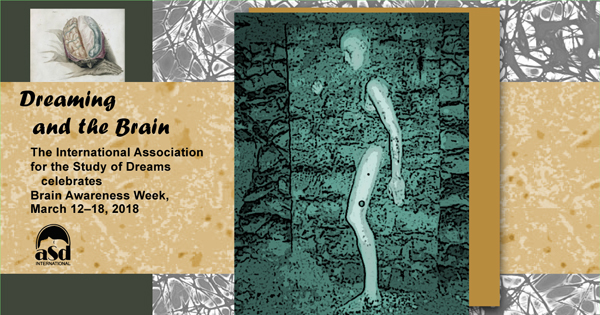 Lucid Dreaming: The Mind Never Sleeps
Lucid Dreaming: The Mind Never Sleeps
By Michael Schredl, PhD
 Modern research indicates that the brain is very active during sleep. One of the functions of sleep is memory consolidation: information taken in during the day is reprocessed during sleep to optimize the memory system. These processes are taking place on a neural level or systems level, in the brain’s networks.
Modern research indicates that the brain is very active during sleep. One of the functions of sleep is memory consolidation: information taken in during the day is reprocessed during sleep to optimize the memory system. These processes are taking place on a neural level or systems level, in the brain’s networks.
So if the brain is so busy, what is the mind doing during sleep? Is it in a state of some form of “unconsciousness” because we don’t remember what the mind is doing during sleep? But what about dreams?
Studies in which the sleeper is awakened during the sleep onset process (sleep stage N, or non-REM, 1), normal sleep (sleep stage N2), deep sleep (sleep stage N3), and rapid eye movement (REM) sleep indicate that the awakened person can quite often remember mental activity that took place before the awakening. In REM sleep, almost every awakening yielded an elaborate dream report (at least in young students). But in more than half the awakenings out of the other sleep stages, the person can also remember something. These findings led to the assumption that the brain’s basic thinking ability seems never to stop, and its ability to produce the experience of a coherent world continues through much of sleep – even without the input of light, acoustic, and other stimuli which are present during wakefulness. The first findings that NREM dreaming is more like wakeful thinking have not been replicated; two studies our research group did on NREM dreaming clearly indicate that N2 and N3 dreaming can be quite similar to REM dreaming, even though the dream reports are on average shorter than REM dreams (Lutz Wittmann, Christina Palmy, and Michael Schredl, 2004, and Michael Schredl, Jaana Brennecke, and Iris Reinhard, 2013).
What are lucid dreams, and why are they so interesting for research?
In a lucid dream, the sleeper is aware that he or she is dreaming. With this awareness, it is possible to wake up deliberately, or to control the dream action, or to observe passively the course of the dream. In a representative sample of adults, about 50% of the participants reported having at least one lucid dream; in student samples, the percentage goes up to 80%. Dreamers with more than one lucid dream per week are rare: about 5%. In Japan the frequency is lower than in Germany or the United States, possibly reflecting culture-dependent attitudes toward lucid dreaming.
Typically, lucid dreaming is fun. The dreamer can choose to do things that are impossible in waking life (such as flying, doing “real” magic, going through walls, or breathing under water), can pursue pleasant activities (sex, for example), can improve skills (sports ability, assertiveness, professional tasks), and can delve into spiritual experiences.
The proficient lucid dreamer can remember and carry out tasks that were prearranged with the experimenter. In the late 1970s, Stephen LaBerge and Keith Hearne independently found that the dreamed eye movements of the lucid dreamer can be measured by a recording machine. After awakening, the lucid dream report was compared to the recordings; the dreamed eye movements (e.g., left-right-left-right) were clearly seen in the recording, and they were clearly distinguishable from the normal eye movements of REM sleep. This fascinating discovery has become a tool in further laboratory studies of lucid dreaming.
Lucid dreaming and the brain
In the sleep laboratory, a lucid dreamer can be instructed to perform an eye signal before starting a specific activity in the dream and at the end of the activity. For example, in the 1980s LaBerge asked lucid dreamers to surround singing in a lucid dream with one type of signal, and counting with another type of signal. This allowed the researchers to establish that singing in the dream was accompanied by higher activation of the brain’s right hemisphere compared to counting in the dream.
In a 2013 study by Daniel Erlacher and colleagues (I was one of them), the lucid dreamers were instructed ahead of time to, in their dreams, count to 10, to 20, and to 30, and also to walk 10 steps, 20 steps, and 30 steps. Interestingly, the ratios of the time used for the different lengths of activity were very stable: 10 steps took half the time that 20 steps took. And counting and walking took, on average, a little more time than in waking (about 30% more for counting, 50% more for walking), clearly contradicting the idea that time speeds up in dreaming.
The most extensive study was done by Martin Dresler in 2011; lucid dreamers slept in a magnetic resonance imaging (MRI) scanner, with electrodes attached to their heads for measuring sleep stages. When lucid in the dream, they performed clenches with the left hand and the right hand. For two lucid dreams of one dreamer, Dresler’s team was able to show increased activity in the left motor cortex if the right hand was clenched and vice versa. The activation was comparable to imagined hand movements in the waking state, but – as expected – of a much lower magnitude compared to real hand movements. Despite many nights in the MRI lab, the research group managed to measure only the one lucid dreamer; the main problems were the noise of the machine and the need in MRI to keep the head from moving by using specific cushions and a holding device.
Almost science fiction are the most advanced experiments with lucid dreaming: the possibility of communicating with the lucid dreamer while she or he is sleeping. Two researchers, Johannes Strelen and Kristoffer Appel, showed that a lucid dreamer can perform different eye signals if she or he is hearing different tones during lucid dreaming; a meaningful message (a simple math problem) was transmitted into the dream via Morse code and answered by the dreamer by using Morse-coded eye movements. The future will show what else is possible while the mind is dreaming and the body sleeps relaxed in bed.
Lucid dreaming is a learnable skill
One of the simplest methods to increase the number of lucid dreams is called “reality checks.” The reality checks are carried out 5 to 10 times during the day by asking oneself whether one is dreaming at that moment, and examining the environment for possible incongruities; some authors suggest looking at one’s hand – for example, counting the fingers. This technique is effective; however, it might take some time to experience the first lucid dream.
In Tibetan Buddhism, there is a tradition of dream yoga, in which the trainee tries to stay conscious while falling asleep. Publications describing it, however, indicate that achieving this goal is very difficult and might take years.
Using external stimuli as a means of inducing lucid dreams is based on the findings that external stimuli can be incorporated into the dream. Typically the device is constructed like a sleep mask; sensors detect the eye movements that are typical for REM sleep, and the mask delivers a stimulus (light or sound) if those eye movements are detected. The task for the dreamer is to recognize the external stimulus and realize that this is the cue to gain lucidity.
A more complex approach is based on findings that the prefrontal cortex is more activated in lucid dreaming than in REM sleep with non-lucid dreaming. The idea is to stimulate the prefrontal cortex from outside and increase the probability of a lucid dream. Using transcranial direct current stimulation, a small amount of current (1 mA) applied via electrodes in the area of the prefrontal cortex showed a small positive effect on dream lucidity compared to a sham condition (no electric current applied), but only in experienced lucid dreamers.
The most potent technique studied so far is the wake-up-back-to-bed technique, typically carried out in the sleep laboratory setting. The participant is allowed to sleep for about 6 hours, then awakened from REM sleep to obtain a “fresh” dream. During the next hour, the participant rehearses this dream and reminds oneself, if I dream this or that [usually this “fresh” dream, but it is possible to work with an older one], then I will become lucid. Then the dreamer can continue sleeping for two or three more hours. Several studies carried out by Daniel Erlacher in his sleep lab at the University of Heidelberg showed that the success rate for dreaming lucidly in this second sleep period was about 50%, even in people not experienced at lucid dreaming. However, so far it is not clear whether this technique is equally effective outside the sleep lab.
Consciousness studies
Lucid dreaming has exciting potential for studying consciousness in its purest form, without any distractions from the real world. On their own, lucid dreamers can experiment with what the imagination is capable of – finding out what it feels like to go through a wall, or asking dream characters questions like “Why are you in my dream?” Researchers are interested in linking lucid dreamers’ subjective experience to objective physiological parameters and brain activation patterns, indirectly observing consciousness when it is not affected by the outside world.
…………………………………………………………………………………………………………………………..
© 2018 Michael Schredl. Michael Schredl, co-chair of the International Association for the Study of Dreams’ Research Committee, heads the sleep laboratory of the Central Institute of Mental Health in Mannheim, Germany. He is co-founder and co-editor of the International Journal of Dream Research, and he has published four books, in German, about dreaming.
Banner images: (Center) Catacombes de Paris – le passe-muraille 1, Vznoupzvr11, altered, CC BY-SA. (Left) Plate 1. Sir Charles Bell, The anatomy of the brain, 1802. Wellcome Collection, CC BY.
The International Association for the Study of Dreams is a nonprofit, international, multidisciplinary organization dedicated to the pure and applied investigation of dreams and dreaming. Our members variously explore dreams through the sciences, the humanities, the arts, clinical applications, and their own experiences. See our website (ASDreams.org) for information on dream research, research grants, membership, and conferences. IASD is a partner in the global Brain Awareness Week campaign of the Dana Alliance, which offers a large selection of brain education materials on its website (dana.org/baw).
